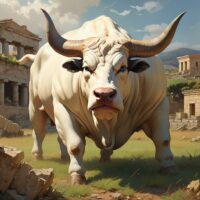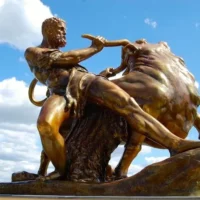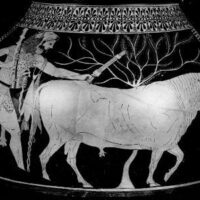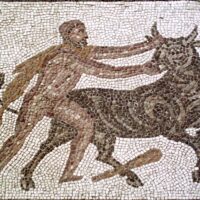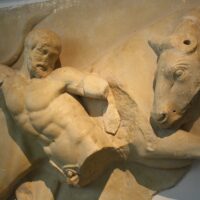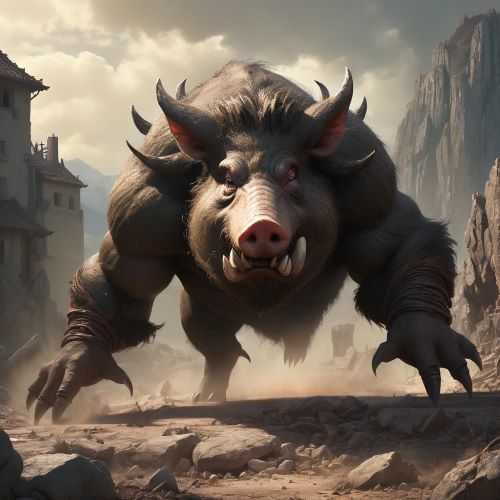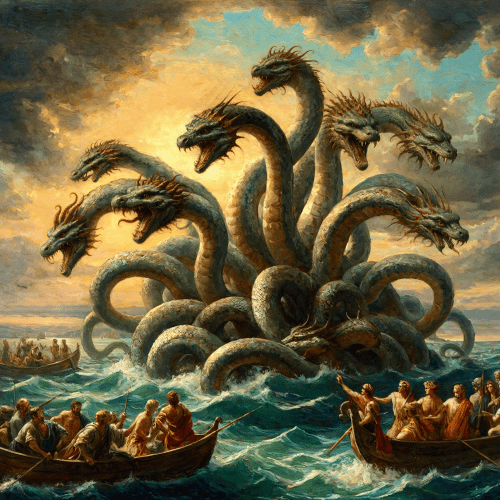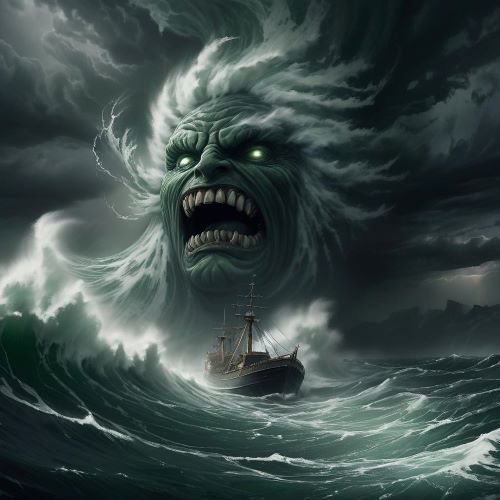Cretan Bull : The Majestic One
Listen
At a glance
| Description | |
|---|---|
| Origin | Greek Mythology |
| Classification | Animals |
| Family Members | N/A |
| Region | Greece |
| Associated With | Size, Beauty |
Cretan Bull
Introduction
In the intricate weave of Greek mythology, the Cretan Bull emerges as a creature both awe-inspiring and enigmatic, its tale entwined with gods, heroes, and the labyrinthine depths of Crete. Born of the sea god Poseidon, this legendary creature has left an indelible mark on ancient tales and continues to captivate imaginations today. The Cretan Bull, a magnificent and monstrous beast from Greek mythology, has captivated storytellers for millennia with its intricate tale of divine favor, deception, monstrous offspring, and heroic deeds.
Physical Traits
The Cretan Bull possessed an extraordinary physique that commanded awe and respect. Its sinewy muscles rippled beneath an obsidian-black hide, and its eyes blazed with an otherworldly fire. Its massive horns curved like crescent moons, poised to pierce the heavens. This bull was not merely livestock; it embodied raw power and stood as a force of nature.
Across different retellings, the physical description of the Cretan Bull exhibits slight variations while maintaining key characteristics. It was consistently depicted as a creature of immense size and power, often portrayed as a bull of unmatched beauty. Its coat, typically described as gleaming snow-white, emitted an otherworldly brilliance. Some accounts emphasize its fearsome horns, sharp enough to pierce any barrier. Certain versions speak of its eyes glowing with an unnatural light, reflecting its divine origins or the madness instilled by Poseidon.
Family
The lineage of the Cretan Bull is deeply rooted in myth and divine intrigue. Born from the forbidden union of Pasiphae, Queen of Crete, and a majestic white bull sent by Poseidon, its bloodline carried a potent essence of the gods. However, fate took a dark turn when Pasiphae’s infatuation led to the birth of the Minotaur, a monstrous hybrid of man and bull that haunted the labyrinth beneath King Minos’s palace.
Poseidon, the god of the sea and earthquakes, summoned the Cretan Bull from the waves to signify his authority and power. This act intertwined the bull’s fate with the kingdom of Minos, shaping the course of mythological history. King Minos, eager to assert his rule, received the bull as a divine gift, intending either to sacrifice it to Poseidon or to showcase his divine right to kingship. Captivated by its beauty, Minos deceived Poseidon by keeping the bull and offering a substitute for sacrifice.
Queen Pasiphae, afflicted with an unnatural infatuation for the bull due to Poseidon’s curse, sought the aid of the craftsman Daedalus. He constructed a wooden cow to conceal her, resulting in the birth of the Minotaur—a chilling symbol of Minos’s deception and divine retribution. Imprisoned within the labyrinth crafted by Daedalus, the Minotaur embodied the consequences of mortal hubris and the wrath of the gods.
While the Minotaur remains the most infamous offspring of the Cretan Bull, other accounts suggest its progeny extended beyond the labyrinth’s confines. Heracles, in one legend, encountered monstrous cattle in Spain believed to be descendants of this legendary creature. The complex family tree of the Cretan Bull is a testament to the intricate interplay between mortals and the divine in Greek mythology.
Other names
The Cretan Bull was known by several names across the Aegean, each reflecting different facets of its mythic presence. Among these was the Marathonian Bull, a title earned from its rampage through the fields of Marathon, and the Bull of Crete, forever linked to its roaming grounds. These names whispered through time, echoing the bull’s enduring legacy.
Referred to by various names in different accounts, the Cretan Bull is also known as the Bull of Minos or the Bull of Crete, emphasizing its close ties to the rulership and mythos of the island. Its most common designation, the Cretan Bull, highlights its origins on Crete. However, other names appear in various sources, such as Tauros Kretaios, translating to “Cretan Bull” in ancient Greek, and the Boeotian Bull, associated with the bull that terrorized Marathon following Heracles’ capture. Each name adds a layer of meaning to the bull’s multifaceted mythological identity.
Powers and Abilities
The Cretan Bull was more than a mere brute; it embodied primal forces of nature. Its thundering hooves churned the earth, causing earthquakes, and its breath carried storms. When it charged, mountains trembled. Heracles, in his Twelve Labors, confronted this formidable creature. With sheer sinew and unwavering courage, he grappled the bull, bringing it under his control. The bull’s power was both its curse and its gift—a testament to the blurred boundaries between mortal and divine.
Possessing immense physical strength, the Cretan Bull could wreak havoc on Crete and beyond. Endowed with divine essence, it exhibited incredible resilience and stamina. Some accounts even suggest the bull was infused with supernatural fury, a manifestation of Poseidon’s anger, which amplified its strength and rendered it nearly impossible to subdue. Beyond its physical might, the bull’s connection to Poseidon potentially granted it control over the earth itself. Legends of Poseidon, often termed the “earth-shaker,” hint at the bull inheriting a faint echo of this power.
Legends recount the bull’s fiery breath, capable of scorching landscapes and striking fear into mortals’ hearts. Its supernatural origins bestowed an aura of invincibility, defying attempts to conquer it through conventional means. The Cretan Bull thus embodied not only physical prowess but also the raw, untamed forces of the natural world, marking it as a creature of both awe and dread in the annals of mythology.
Modern Day Influence
The Cretan Bull’s enduring legacy transcends the boundaries of ancient mythology, resonating deeply within modern culture. Its symbolic significance is far-reaching, manifesting in art, literature, and even contemporary sports. The Marathon, a grueling race named after the bull’s legendary rampage, pays homage to its wild sprint across the plains of Marathon. Architects draw inspiration from its majestic form, incorporating elements reminiscent of the bull’s horns into building designs that reach skyward. In digital realms, the Cretan Bull gallops anew through websites and podcasts that delve into its lore, dissecting its impact on culture and society. Its image adorns banners and logos, serving as a silent reminder of ancient power and mythical prowess.
Across literature, the Cretan Bull makes prominent appearances in both classic and contemporary works. Notably, Rick Riordan’s Percy Jackson series features the bull as one of Heracles’ labors, weaving mythological elements into modern storytelling. The Minotaur, the bull’s monstrous offspring, continues to captivate audiences in fantasy fiction, embodying themes of mystery and the clash between human and divine forces. In the realm of visual arts, the bull has been depicted in sculptures, paintings, and mosaics throughout history. One notable example is a sixth-century BC Attic black-figure amphora that portrays Heracles capturing the Cretan Bull, immortalizing the myth in timeless artistry.
Film and media further amplify the Cretan Bull’s presence in contemporary culture. The creature has made notable appearances in films like “Clash of the Titans” (2010) and “Percy Jackson: Sea of Monsters” (2013), introducing new generations to its mythical prowess and captivating narrative. These cinematic interpretations serve as modern interpretations of ancient legends, bridging the gap between past and present while preserving the bull’s legacy for future audiences. In corporate branding and popular culture, the bull’s image persists, symbolizing untamed strength and primal instincts, and serving as a powerful emblem of ancient mythology in the modern world.
Related Images
Frequently Asked Questions
What is lorem Ipsum?
I am text block. Click edit button to change this text. Lorem ipsum dolor sit amet, consectetur adipiscing elit. Ut elit tellus, luctus nec ullamcorper mattis, pulvinar dapibus leo.
What is lorem Ipsum?
I am text block. Click edit button to change this text. Lorem ipsum dolor sit amet, consectetur adipiscing elit. Ut elit tellus, luctus nec ullamcorper mattis, pulvinar dapibus leo.
What is lorem Ipsum?
I am text block. Click edit button to change this text. Lorem ipsum dolor sit amet, consectetur adipiscing elit. Ut elit tellus, luctus nec ullamcorper mattis, pulvinar dapibus leo.
What is lorem Ipsum?
I am text block. Click edit button to change this text. Lorem ipsum dolor sit amet, consectetur adipiscing elit. Ut elit tellus, luctus nec ullamcorper mattis, pulvinar dapibus leo.
What is lorem Ipsum?
I am text block. Click edit button to change this text. Lorem ipsum dolor sit amet, consectetur adipiscing elit. Ut elit tellus, luctus nec ullamcorper mattis, pulvinar dapibus leo.

